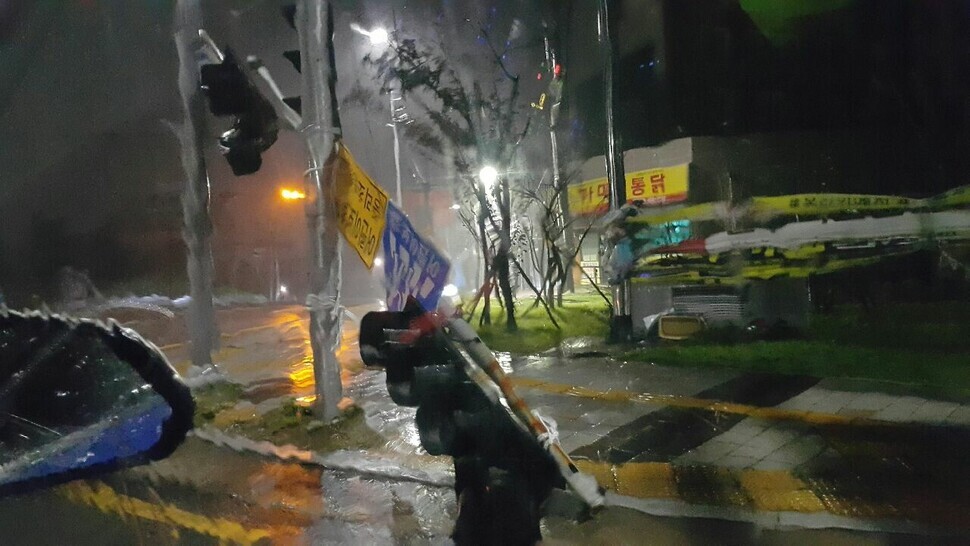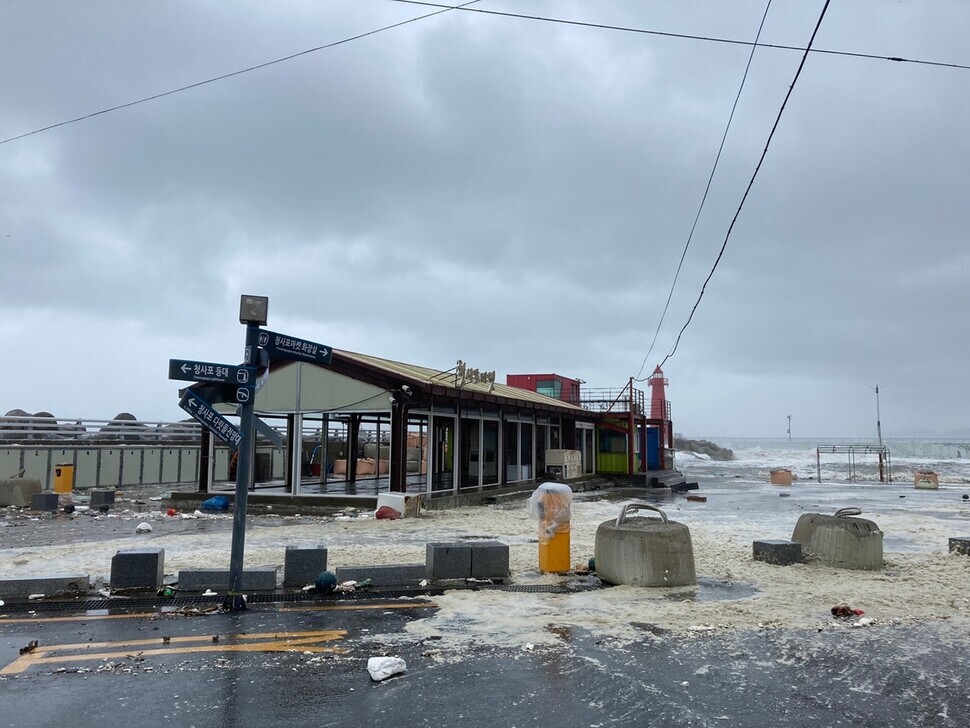hankyoreh
Links to other country sites 다른 나라 사이트 링크
Typhoon Haishen wreaks havoc on Gangwon, N. Gyeongsang Provinces as 2 go missing and dozens are injured

Two people are missing in Gangwon and North Gyeongsang Province and around a dozen citizens and police officers are injured in Busan, Ulsan, and elsewhere in the wake of Typhoon Haishen, the 10th tropical storm of the season, which arrived in South Korea on Sept. 7 -- just four days after the country suffered a battering from the ninth storm, Typhoon Maysak. In addition, two reactors were taken offline at the Wolseong Nuclear Power Plant in Gyeongju.
In Daepyeong, a village in the Singi township of Samcheok, Gangwon Province, a man in his 40s affiliated with a limestone business disappeared after being swept away by rainwater at around 11:23 am on Sept. 7. Firefighting authorities are basing their search efforts on reports that the man was carried into a drain by the swollen waters. The missing man was determined to have been leaving the scene of a limestone mining site with around ten coworkers when he fell into the drain due to a washed-out road around 50 meters away from their work site and was swept away.
A 60-year-old man in the Maehwa township of Uljin County, North Gyeongsang Province, also disappeared while crossing a stream in a tractor at around 12:18 pm. Firefighting authorities believe the man was swept away by a heavy current while crossing a bridge. They are currently conducting search efforts, including the placement of a net downstream.

1-ton truck knocked over by strong winds in Busan
In Busan, a one-ton truck was knocked over by heavy winds at around 7:30 am while it was traveling on Gwangan Bridge, which connects the city’s Nam (South) and Haeundae Districts. A fire truck sent to the scene in response to the report was parked next to the overturned truck to block the wind while a police car approached the vehicle to rescue the driver. According to firefighters, six people were identified as having been injured, including a person in their 60s in the Nam District who was taken to a nearby hospital at around 9:15 am after being struck in the head by a signboard that had been placed as a restroom partition.
Ulsan, where the typhoon made landfall around 9 am, also took significant damage. According to police, five people were reported injured, including a police officer injured in the Dal neighborhood of the city’s Nam (South) District at around 8:10 am while clearing away a metal sign that had fallen onto a road. Another person was injured by glass from a window shattered by a toppling container box at KCC’s Ulsan factory. Twenty-three power outages also occurred, resulting in production issues for some of the businesses located in the Maegok Industrial Complex in the city’s Buk (North) District, which is home to Hyundai Motor’s fifth Ulsan factory, Hyundai Mobis, and numerous automobile and shipbuilding partner companies.
Gangwon Province suffered from reservoir and stream flooding, soil loss, road inundation, and falling rocks in different locations after being hit with torrential rains reaching 70 millimeters per hour. In Goseong, an evacuation order was issued for residents due to concerns about flooding at five reservoirs and streams. A landslide on National Route 46 halted traffic in both directions at Jinburyeong in Goseong, while National Route 38 was flooded at the village of Neukgu in Dogye Town, Samcheok. Roads were closed to vehicle traffic at Anmok Junction and other locations in the Gangneung region due to excessive rainwater.
Turbine generators at Wolseong Nuclear Power Plant go offline; power outages in 75,237 householdsTurbine generators for the second and third reactors at the Wolseong Nuclear Power part in the Yangnam township of Gyeongju, North Gyeongsang Province, were also shut down due to the effects of the typhoon. Turbine generator operation was suspended first for the second reactor at around 8:38 am and then for the third at around 9:18 am. A turbine generator is a device that produces electricity by using the steam from a reactor to turn a turbine. The power plant’s headquarters explained, “The turbine generator went offline automatically because of design properties to keep the power plant safe while irregularities occurred with the power equipment due to the typhoon.”
According to the Central Disaster and Safety Countermeasure Headquarters (CDSCHQ), 75,237 households had suffered power outages as of 4:30 pm on Sept. 7, most of them in the cities of Busan, Ulsan, and Daegu within the area immediately impacted by the typhoon. Emergency restoration had been completed for 49,643 of the households, and restoration was under way at the time for the remaining 25,594. A total of 2,632 people from 1,824 households were evacuated ahead of time from regions in South Korea deemed to be at risk of disasters such as flooding, landslides, and damage to old buildings.
By Kim Yeong-dong, Busan correspondent, Park Soo-hyuk, Gangwon correspondent, Kim Il-woo, Daegu correspondent, and Sin Dong-myeong, Ulsan correspondent
Please direct comments or questions to [english@hani.co.kr]

Editorial・opinion
![[Column] The state is back — but is it in business? [Column] The state is back — but is it in business?](https://flexible.img.hani.co.kr/flexible/normal/500/300/imgdb/original/2024/0506/8217149564092725.jpg) [Column] The state is back — but is it in business?
[Column] The state is back — but is it in business?![[Column] Life on our Trisolaris [Column] Life on our Trisolaris](https://flexible.img.hani.co.kr/flexible/normal/500/300/imgdb/original/2024/0505/4817148682278544.jpg) [Column] Life on our Trisolaris
[Column] Life on our Trisolaris- [Editorial] Penalties for airing allegations against Korea’s first lady endanger free press
- [Editorial] Yoon must halt procurement of SM-3 interceptor missiles
- [Guest essay] Maybe Korea’s rapid population decline is an opportunity, not a crisis
- [Column] Can Yoon steer diplomacy with Russia, China back on track?
- [Column] Season 2 of special prosecutor probe may be coming to Korea soon
- [Column] Park Geun-hye déjà vu in Yoon Suk-yeol
- [Editorial] New weight of N. Korea’s nuclear threats makes dialogue all the more urgent
- [Guest essay] The real reason Korea’s new right wants to dub Rhee a founding father
Most viewed articles
- 1[Column] Why Korea’s hard right is fated to lose
- 2Amid US-China clash, Korea must remember its failures in the 19th century, advises scholar
- 360% of young Koreans see no need to have kids after marriage
- 4[Column] Can Yoon steer diplomacy with Russia, China back on track?
- 5[Column] The state is back — but is it in business?
- 6[Editorial] Stagnant youth employment poses serious issues for Korea’s future
- 7Hybe-Ador dispute shines light on pervasive issues behind K-pop’s tidy facade
- 8Inside the law for a special counsel probe over a Korean Marine’s death
- 9Japan says it’s not pressuring Naver to sell Line, but Korean insiders say otherwise
- 10Presidential office warns of veto in response to opposition passing special counsel probe act